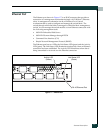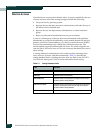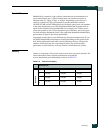
McDATA 4416 Fibre Channel Switch Module Installation Guide
2-6
Multiple Chassis Fabrics
Multiple Chassis Fabrics
By connecting switches together you can expand the number of available
ports for devices. Each switch in the fabric is identified by a unique domain
ID, and the fabric can automatically resolve domain ID conflicts. Because the
Fibre Channel ports are self-configuring, you can connect switches together in
a wide variety of topologies.
Optimizing Device Performance
When choosing a topology for a multiple chassis fabric, you should also
consider the locality of your server and storage devices and the performance
requirements of your application. Storage applications such as video
distribution, medical record storage/retrieval or real-time data acquisition
can have specific latency or bandwidth requirements.
The switch module provides the lowest latency of any product in its class.
Refer to “Performance” on page 2-4 for information about latency. However,
the highest performance is achieved on Fibre Channel switches by keeping
traffic within a single switch instead of relying on ISLs. Therefore, for optimal
device performance, place devices on the same switch module under the
following conditions:
• Heavy I/O traffic between specific server and storage devices.
• Distinct speed mismatch between devices
Domain ID, Principal Priority, and Domain ID Lock
The following switch configuration settings affect multiple chassis fabrics:
•Domain ID
• Principal priority
•Domain ID lock
The domain ID is a unique number that identifies each switch in a fabric. The
valid domain ID range depends on the interoperability mode:
• When the interoperability mode is Standard, the domain ID can be
97–127.
• When the interoperability mode is McDATA Fabric Mode, the domain ID
can be 1–31.
The principal priority is a number (1–255) that determines the principal
switch which manages domain ID assignments for the fabric. The switch with
the highest principal priority (1 is high, 255 is low) becomes the principal
switch. If the principal priority is the same for all switches in a fabric, the
switch with the lowest WWN becomes the principal switch.


















